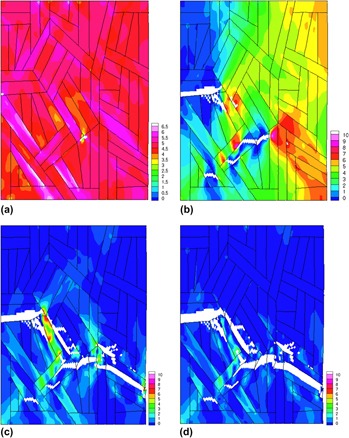Crossref Citations
This article has been cited by the following publications. This list is generated based on data provided by
Crossref.
Shanthraj, Pratheek
and
Zikry, Mohammed A.
2013.
Handbook of Damage Mechanics.
p.
1.
Shanthraj, P.
and
Zikry, M.A.
2013.
The effects of microstructure and morphology on fracture nucleation and propagation in martensitic steel alloys.
Mechanics of Materials,
Vol. 58,
Issue. ,
p.
110.
Na, Hyuntaek
Nambu, Shoichi
Ojima, Mayumi
Inoue, Junya
and
Koseki, Toshihiko
2013.
Strain localization behavior in low-carbon martensitic steel during tensile deformation.
Scripta Materialia,
Vol. 69,
Issue. 11-12,
p.
793.
Khanikar, Prasenjit
Liu, Yi
and
Zikry, M.A.
2014.
Experimental and computational investigation of the dynamic behavior of Al–Cu–Li alloys.
Materials Science and Engineering: A,
Vol. 604,
Issue. ,
p.
67.
Khanikar, Prasenjit
and
Zikry, M.A.
2014.
High strain-rate interfacial behavior of layered metallic composites.
Mechanics of Materials,
Vol. 77,
Issue. ,
p.
52.
Na, Hyuntaek
Nambu, Shoichi
Ojima, Mayumi
Inoue, Junya
and
Koseki, Toshihiko
2014.
Crystallographic and Microstructural Studies of Lath Martensitic Steel During Tensile Deformation.
Metallurgical and Materials Transactions A,
Vol. 45,
Issue. 11,
p.
5029.
Shanthraj, Pratheek
and
Zikry, Mohammed A.
2015.
Handbook of Damage Mechanics.
p.
419.
Lindroos, Matti
Valtonen, Kati
Kemppainen, Anu
Laukkanen, Anssi
Holmberg, Kenneth
and
Kuokkala, Veli-Tapani
2015.
Wear behavior and work hardening of high strength steels in high stress abrasion.
Wear,
Vol. 322-323,
Issue. ,
p.
32.
Wang, Ding
Shanthraj, Pratheek
Springer, Hauke
and
Raabe, Dierk
2018.
Particle-induced damage in Fe–TiB2 high stiffness metal matrix composite steels.
Materials & Design,
Vol. 160,
Issue. ,
p.
557.
Roters, F.
Diehl, M.
Shanthraj, P.
Eisenlohr, P.
Reuber, C.
Wong, S.L.
Maiti, T.
Ebrahimi, A.
Hochrainer, T.
Fabritius, H.-O.
Nikolov, S.
Friák, M.
Fujita, N.
Grilli, N.
Janssens, K.G.F.
Jia, N.
Kok, P.J.J.
Ma, D.
Meier, F.
Werner, E.
Stricker, M.
Weygand, D.
and
Raabe, D.
2019.
DAMASK – The Düsseldorf Advanced Material Simulation Kit for modeling multi-physics crystal plasticity, thermal, and damage phenomena from the single crystal up to the component scale.
Computational Materials Science,
Vol. 158,
Issue. ,
p.
420.
Shanthraj, P.
Liu, C.
Akbarian, A.
Svendsen, B.
and
Raabe, D.
2020.
Multi-component chemo-mechanics based on transport relations for the chemical potential.
Computer Methods in Applied Mechanics and Engineering,
Vol. 365,
Issue. ,
p.
113029.
Shanthraj, Pratheek
and
Zikry, Mohammed A.
2022.
Handbook of Damage Mechanics.
p.
1301.
Ren, Pengxu
Hamada, Shigeru
Itoh, Daisuke
Makino, Taizo
and
Noguchi, Hiroshi
2024.
Fatigue crack extension mechanism and mode-type analyses of martensitic steels for proposing fatigue strength evaluation method: Example of 18% Ni BCC martensitic steel.
Theoretical and Applied Fracture Mechanics,
Vol. 133,
Issue. ,
p.
104594.
Koschella, Kevin
and
Krupp, Ulrich
2024.
Progress in Structural Mechanics.
Vol. 199,
Issue. ,
p.
209.
Ren, Pengxu
Hamada, Shigeru
Ueki, Shohei
Itoh, Daisuke
Makino, Taizo
and
Noguchi, Hiroshi
2025.
Fatigue strength evaluation method based on fatigue crack extension mechanism in BCC martensitic steels.
International Journal of Fatigue,
Vol. 193,
Issue. ,
p.
108784.


